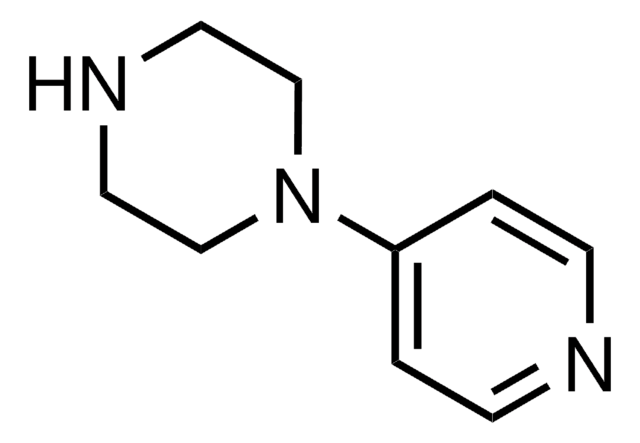421235
1-(2-Pyrimidyl)piperazine
98%
Synonim(y):
2-(1-Piperazinyl)pyrimidine
About This Item
Polecane produkty
Próba
98%
współczynnik refrakcji
n20/D 1.587 (lit.)
tw
277 °C (lit.)
gęstość
1.158 g/mL at 25 °C (lit.)
ciąg SMILES
C1CN(CCN1)c2ncccn2
InChI
1S/C8H12N4/c1-2-10-8(11-3-1)12-6-4-9-5-7-12/h1-3,9H,4-7H2
Klucz InChI
MRBFGEHILMYPTF-UHFFFAOYSA-N
Szukasz podobnych produktów? Odwiedź Przewodnik dotyczący porównywania produktów
Opis ogólny
Zastosowanie
- As derivatization reagent for the carboxyl groups on peptides.
- Carboxy group derivatization during the spectrophotometric analysis of phosphopeptides.
- Starting reagent for the synthesis of 3-{(4-(pyrimidin-2-yl)piperazin-1-yl)methyl}-1H-pyrrolo[2,3-b]pyridine.
- Synthesis of 3-phenyl-6-(4-(pyrimidin-2-yl)piperazin-1-yl)pyridazin-4-ol.
Hasło ostrzegawcze
Warning
Zwroty wskazujące rodzaj zagrożenia
Zwroty wskazujące środki ostrożności
Klasyfikacja zagrożeń
Eye Irrit. 2 - Skin Irrit. 2 - STOT SE 3
Organy docelowe
Respiratory system
Kod klasy składowania
10 - Combustible liquids
Klasa zagrożenia wodnego (WGK)
WGK 3
Temperatura zapłonu (°F)
>230.0 °F
Temperatura zapłonu (°C)
> 110 °C
Środki ochrony indywidualnej
Eyeshields, Gloves, type ABEK (EN14387) respirator filter
Certyfikaty analizy (CoA)
Poszukaj Certyfikaty analizy (CoA), wpisując numer partii/serii produktów. Numery serii i partii można znaleźć na etykiecie produktu po słowach „seria” lub „partia”.
Masz już ten produkt?
Dokumenty związane z niedawno zakupionymi produktami zostały zamieszczone w Bibliotece dokumentów.
Klienci oglądali również te produkty
Nasz zespół naukowców ma doświadczenie we wszystkich obszarach badań, w tym w naukach przyrodniczych, materiałoznawstwie, syntezie chemicznej, chromatografii, analityce i wielu innych dziedzinach.
Skontaktuj się z zespołem ds. pomocy technicznej









